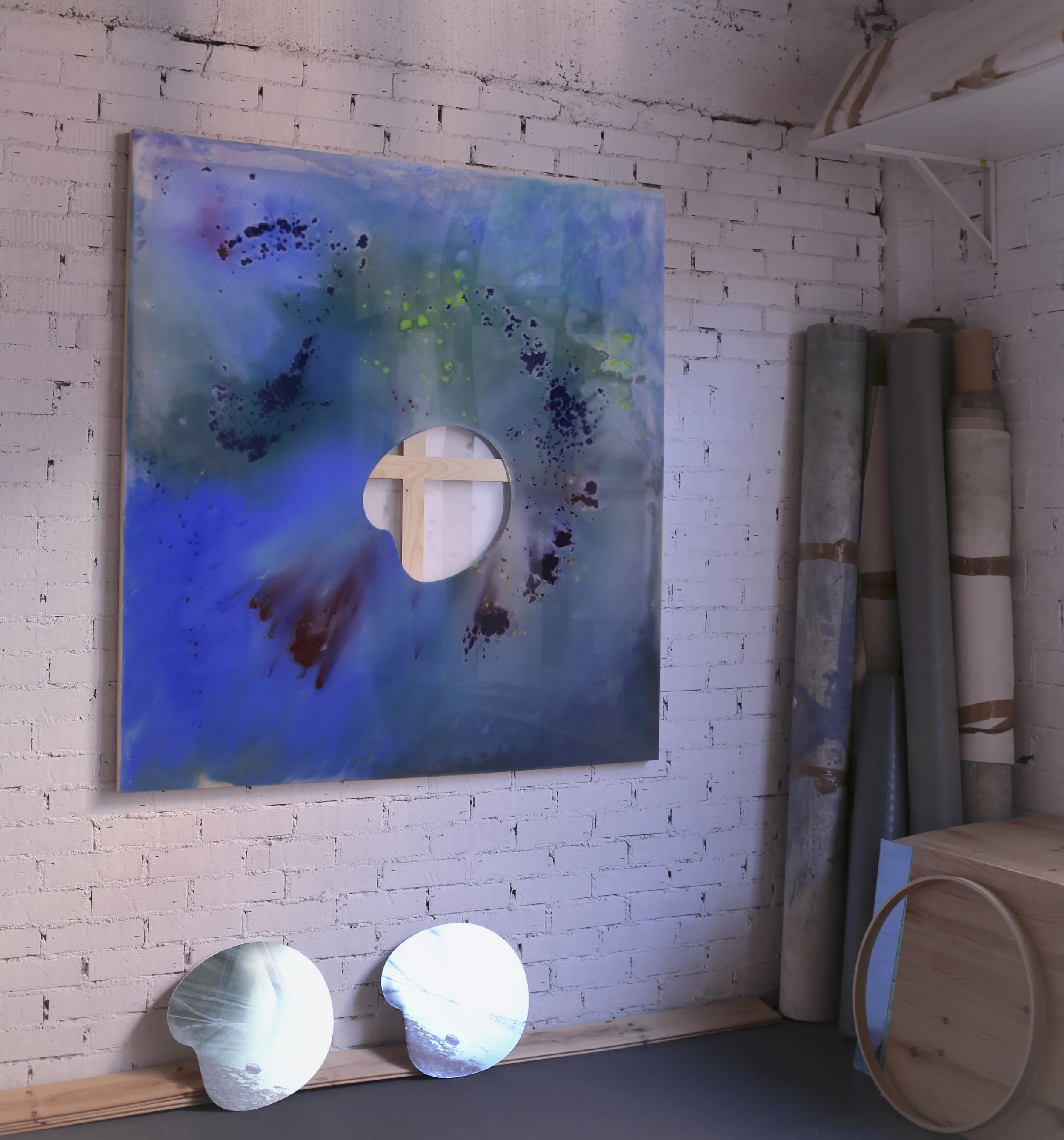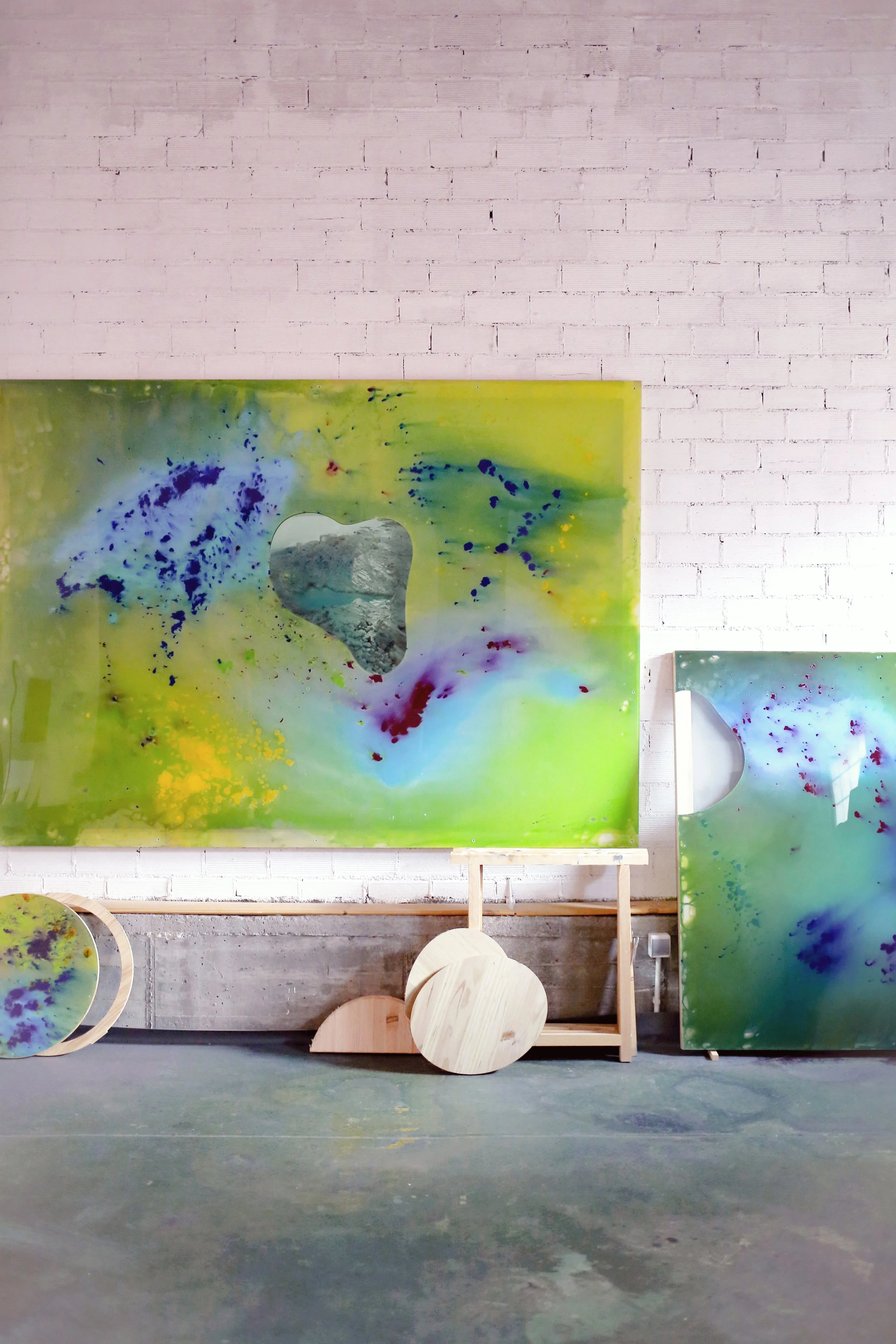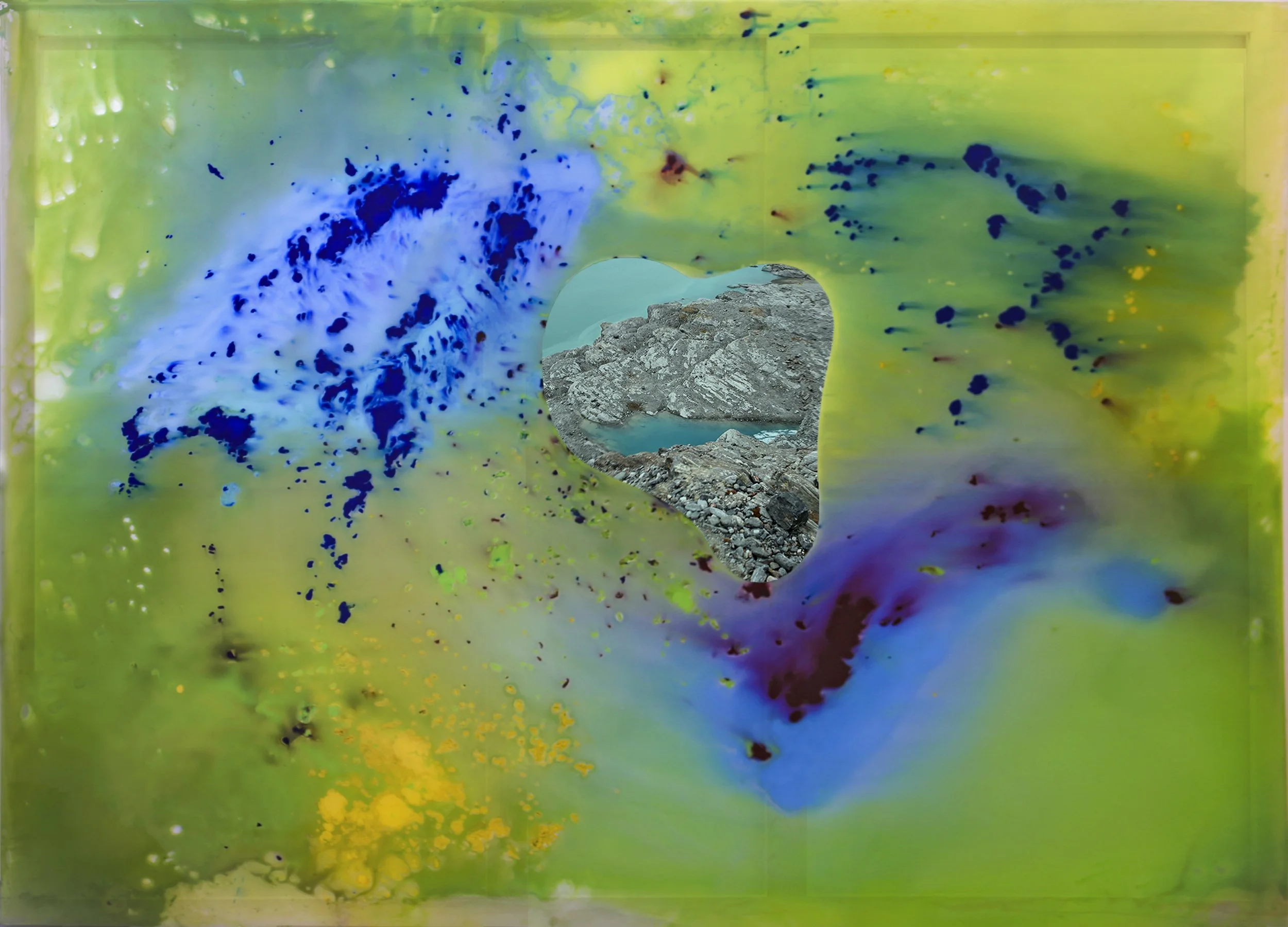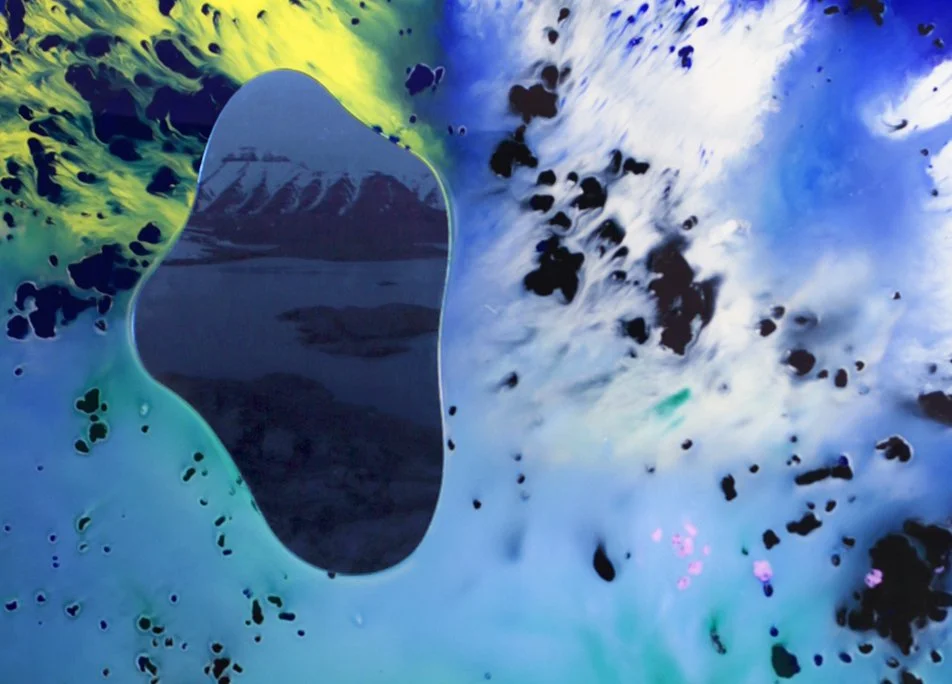Spatial Abstractions: Cristina Gamon in conversation with SARAHCROWN
This month we met with Spanish artist Cristina Gamon, whose spatial installations are very much up our alley.
“My works are characterized by the morphology of their cut-out shapes that break the composition’s space by leaving voids within their abstract landscapes. The drawing shapes of the missing cut-outs resemble portals of transition.
Thresholds II (mise en abyme installation view)
SARAHCROWN: Cristina, what are your main sources of inspiration?
Cristina Gamon: When creating an artwork, different layers of visual, poetic and conceptual research coexist all at once, while maintaining the focus on the contemplative aspect in art. In my creative process I get inspired by essays and philosophy papers which activate my imagination. I am interested in revisiting the History of Art, especially the legacy of painting, building bridges between past and present. I consider that painting still seduces and I am interested in pursuing it. From a pictorial point of view, I make use of other disciplines to enhance these discourses through a more expanded painting practice. For example, as I work on lyrical abstraction on clear acrylic sheets, reflection, transparency and shine are inherent to this material. Thus, at my last solo exhibition in Spain, Mirages, I decided to address the idea of reflection bringing up themes such as mimesis, duality or trompe l'oeil influenced by the history of the mirror and myths. The series I am currently working on “Threshold. Bordering natures” are a natural evolution derived from that show.” Since ancient times, the first mirrors were indeed the landscape itself, that is, natural caves or wells that appeared as portals blocked from view. Thus, from the crystalline waters that reflected Narcissus to the possible industrialization of quality mirrors, their history maintains an artistic and magical-ritual bond with the landscape that is being present in authors such as Magritte or Robert Smithson. In my recent pieces the idea of landscape is reflected almost literally in the works.
Bordering Natures IV (installation view)
SC: Are there recurring themes or concepts that shape your artworks?
CG: My art practice articulates around the idea of painting as an image. I focus my attention on the invisible barriers of diffuse polarity within the visual arts as a constant exercise of duality between fiction and reality. A possible approach to my work is that I start from the literalness of the constitutive elements of the painting as a window, in line with the Renaissance’s definition: “The painting is a transparent window through which we look out into the visible world”. (LB Alberti) Thus, clear acrylic sheets work as a transparent membrane and the stretcher bars would depict the window. From there, I approach an experimental painting of expressionist lyrical abstraction with elusive atmospheres of color applied on clear plastic mounted with stretcher bars. The transparency of the material allows us to glimpse “behind the scenes”, it makes us participate in the artifice of painting by letting us guess the structure of the painting. At the same time, the sensuality of the materials and the expression of its gesture are trapped behind the plastic material that, common to our screen-society daily life, shows our emotions from the other side of that safe invisible barrier, making us believe sensations that are apparently accessible thanks to the transparency of its lie. My works are characterized by the morphology of their cut-out shapes that break the composition’s space by leaving voids within their abstract landscapes. The drawing shapes of the missing cut-outs resemble portals of transition, like those thresholds that, since the Romantic era, have been associating landscape and metaphor, projection and reflection; in short, with painting as a window.
Bordering Natures V (installation view)
SC: Tell us about your creative process. How does the creation of an artwork begin and end?
CG: As mentioned above, I am inspired by writings and I start from an idea to design a series or exhibition. I make decisions on the composition, format and specific palette of each painting attending the conceptual coherence of the complete whole set. By the time the action of painting comes, many formal decisions have already been made. The challenge is to stay focused and aware of the project route while maintaining the same spirit throughout the process of the series. In “contemplative painting”, to paint is not so much a matter of craft and routine but a decisive moment that begins the moment I wake up. When I paint, I must stay aligned with the emotions I want to project. For that reason, I try not to contaminate my thinking while in the process; preventing anything else from becoming relevant. I like to maintain a work schedule and when I am in the studio, these processes do not apply. There, I don't check my emails nor phone or know when I might leave the studio. I need all my energy to be focused on that precise creative moment.
SC: Tell us more about the deconstructed frames and spatial interventions.
CG: I think you might be referring to the installation Mise En Abyme. This term is generally known as the technique of placing a copy of an image within itself in a way that suggests an infinitely recurring sequence. “A story within a story,” “a picture within a picture". The work reflects on the limits between reality and fiction, conceiving space as occupied margins. The exhibition space becomes a stage; both a framed space and a framework, an intermediary between the room and the painting.
In the studio of Cristina Gamon
SC: Describe your studio or workspace. Do you keep objects or routines?
CG: My studio is an open space basement with lots of natural light and an industrial vibe. At first, I did not know the neighborhood and now it seems an artistic community is beginning to grow here. I suppose having gone through several studio-spaces, the last was before the pandemic at the College of Spain in Paris granted by the Ministry of Culture, made me used to adjusting nomadically to different studios (with all the consequences that implies, if you think about my technique and the logistics needed). [...] I guess I don’t really have amulets or fetish objects around my studio. I reserve them for home, my refuge. In past few years, I got accustomed to certain encounters and routines. I look for the shadow of the cat that lies in the sun, or take care of the plants.
Bordering Natures VI, Mixed media on plexiglas and wooden stretcher bars. 2023.
SC: How has technology impacted your artistic process, if at all?
CG: The Internet is an enriching and unlimited tool that makes it possible to delve deeper into our interests. I try to compose my own “Mnenosyne atlas”, so to speak, and I hope that over the years I can unfold my research and discover the conceptual, visual and formal coherence between my obsessions reflected through my work. I use computer programs for drafting and designing my work, which in my case is necessary for the laser-cuts on industrial materials and such.
The immediacy of digital globalization along with social media impacts in a way that we can no longer be surprised for and it is generating an overlapping standardization of artistic trends. We are facing an era of “rapid consumption mannerisms.” I cannot judge if it’s for good or for bad, but it is a mirror of the society of this time. What I do hope is that AI, despite all its disrupting potential, will emphasize the value of unique and manually made art.
We can generally define art as a safe place of fiction where we express our ideas, desires, fears, fantasies. Perhaps technology is already leveled up in both quality and creativity compared to human intelligence skills, but we must not forget that the need to manifest ourselves through what we understand today as artistic manifestations, is an inherited vital impulse, a need of mankind. In that sense, painting is already a declaration of intent. To fully understand my work, you must be present. Not only is it a matter of better appreciating the technique or the size but because our visual attitude varies depending on the context and to truly contemplate a piece, physical experience must be implied. A virtual encounter cannot replace it.
Bordering Natures V (detail)
SC: Describe your favorite artwork made by an artist you admire. Why is it your favorite work?
CG: I like this question because I am not a fan of “favorites” and it is difficult for me to choose this single artist who honestly interests me throughout his/her entire body of his work. But I could defitnetly choose one piece per artist that I like. The first one that came to mind is the photographic series or photobook “You are the Weather” by Roni Horn.
I was hesitant about The Weather Project by Olafur Eliasson but I didn't have the opportunity to see it in person. It is curious to realize how both pieces allude to climate and Iceland. I think it is a coincidence and that my interest comes from how each piece in its own style brings a hypnotic connection with the viewer, sensual and ineffable that touches you from the inside.
However, I must admit that I had always been intrigued by those icy landscapes and, in fact, this summer solstice it will be 10 years since I traveled to the Geographic North Pole on the artist & scientist expeditionary program from The Arctic Circle. This residency gets a little apart from the traditional circuits that I am used to and yet the experience is memorable since it is a sailing trip on a tall ship barquentine fjord-landing the Spitsbergen archipelago. Along the voyage I produced Sinik, a site-specific piece painted during the Midnight Sun’s nights. A color trip log inspired by the poetics from Inuit language where distances are measured in dreams.
SC: If you weren’t an artist, what would you do?
CG: Painting and drawing have been a part of me since childhood and thanks to my family support, I had an early academic training education that would lead me to the University of Arts in Valencia, so I guess it couldn't be any other way. I would have loved to have musical training as well, but I was inclined towards painting. I enjoy everything that is artistically related -opera, cinema, museology. I think it would have definitely ended up involved in art or creativity anyway!
Cristina Gamon in her studio







